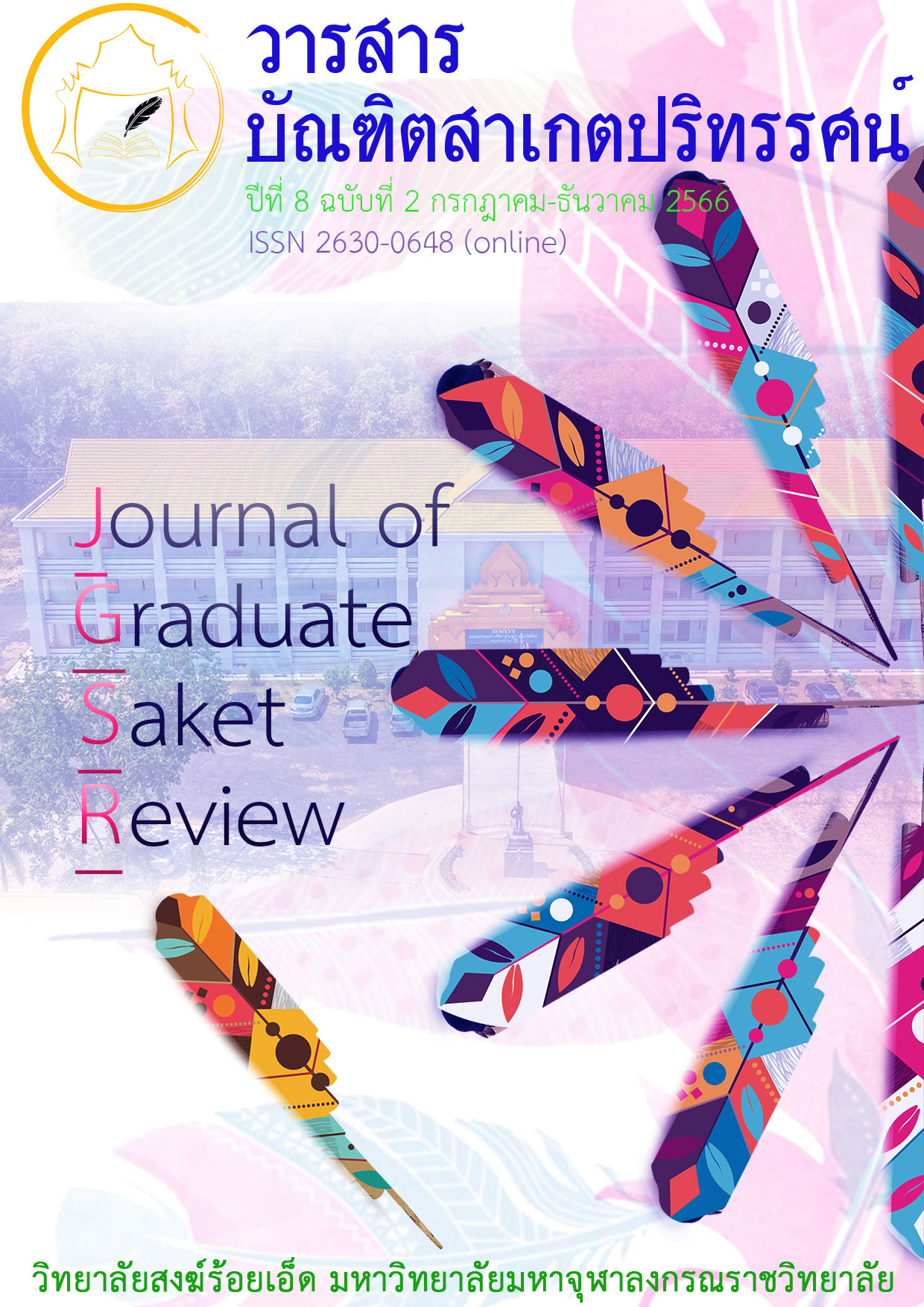พฤติกรรมและการรู้เท่าทันสื่อสังคมออนไลน์ของนักศึกษามหาวิทยาลัยมหามกุฏราชวิทยาลัย วิทยาเขตศรีล้านช้าง
Main Article Content
บทคัดย่อ
การวิจัยครั้งนี้มีวัตถุประสงค์ เพื่อ 1) ศึกษาพฤติกรรมการใช้สื่อสังคมออนไลน์ ของนักศึกษา 2) ศึกษาการรู้เท่าทันสื่อสังคมออนไลน์ของนักศึกษา มหาวิทยาลัยมหามกุฏราชวิทยาลัย วิทยาเขตศรีล้านช้าง ใช้ระเบียบวิธีวิจัยเชิงปริมาณ กลุ่มตัวอย่างที่ใช้ในการวิจัยคือ นักศึกษามหาวิทยาลัยมหามกุฏราชวิทยาลัยวิทยาเขตศรีล้านช้าง จำนวน 148 รูป/คน ใช้วิธีสุ่มแบบหลายขั้นตอน เครื่องมือที่ใช้ในการวิจัย เป็นแบบสอบถาม วิเคราะห์ข้อมูลโดยใช้สถิติพรรณนาในรูปของจำนวน ร้อยละ ค่าเฉลี่ย ส่วนเบี่ยงเบนมาตรฐาน
ผลการวิจัย พบว่า
1. นักศึกษาส่วนใหญ่เป็นเพศหญิง มีอายุน้อยกว่า 21ปี ศึกษาอยู่สาขาวิชาการปกครอง ศึกษาอยู่ในชั้นปีที่1 มีเกรดเฉลี่ยระหว่าง 3.00-3.50 และพักอาศัยอยู่กับ บิดา มารดา
2. นักศึกษาส่วนใหญ่มีพฤติกรรมใช้สื่อสังคมออนไลน์ผ่านช่องทางประเภท เฟสบุ๊ก ใช้อุปกรณ์สมาร์ทโฟน ใน 1 สัปดาห์เข้าใช้สื่อสังคมออนไลน์มากกว่า6วัน เนื้อหาที่สืบค้นส่วนใหญ่เป็นการศึกษา ช่วงวันธรรมดาและวันหยุด ใช้เวลาเฉลี่ยวันละ 5-10 ชั่วโมง ช่วงเวลาในเข้าใช้ส่วนใหญ่เป็นช่วงเย็น (16.00น. –19.00น.) สถานที่เข้าถึงส่วนใหญ่เป็นบ้านตนเอง และวัตถุประสงค์ในการเข้าใช้ส่วนใหญ่เพื่อสืบค้นเนื้อหาทางการศึกษา
3. นักศึกษามีการรู้เท่าทันสื่อสังคมออนไลน์ ในภาพรวมอยู่ในระดับมาก เมื่อพิจารณาเป็นรายด้าน พบว่า ทุกด้านอยู่ในระดับมาก ด้านที่มีค่าเฉลี่ยมากที่สุดคือ ด้านการประเมินสื่อสังคมออนไลน์ รองลงมา ด้านการประเมินสื่อสังคมออนไลน์ และ ด้านเข้าใจสื่อสังคมออนไลน์ ส่วนด้านที่มีค่าเฉลี่ยต่ำที่สุด คือ ด้านความตระหนักรู้สื่อสังคมออนไลน
Article Details

อนุญาตภายใต้เงื่อนไข Creative Commons Attribution-NonCommercial-NoDerivatives 4.0 International License.
เนื้อหาและข้อมูลในบทความที่ลงตีพิมพ์ในวารสารบัณฑิตสาเกตปริทรรศน์ ถือเป็นข้อคิดเห็นและความรับผิดชอบของผู้เขียนบทความโดยตรงซึ่งกองบรรณาธิการวารสาร ไม่จำเป็นต้องเห็นด้วย หรือร่วมรับผิดชอบใด ๆบทความ ข้อมูล เนื้อหา รูปภาพ ฯลฯ ที่ได้รับการตีพิมพ์ในวารสารบัณฑิตสาเกตปริทรรศน์ ถือเป็นลิขสิทธิ์ของวารสารบัณฑิตสาเกตปริทรรศน์ หากบุคคลหรือหน่วยงานใดต้องการนำทั้งหมดหรือส่วนหนึ่งส่วนใดไปเผยแพร่ต่อหรือเพื่อกระทำการใด ๆ จะต้องได้รับอนุญาตเป็นลายลักอักษรจากวารสารบัณฑิตสาเกตปริทรรศน์ ก่อนเท่านั้น
เอกสารอ้างอิง
กระทรวงดิจิทัลเพื่อเศรษฐกิจและสังคม.(2562). ETDA เผย ปี 62 คนไทยใช้อินเทอร์เน็ตเพิ่มขึ้นเฉลี่ย 10 ชั่วโมง 22 นาที Gen Y ครองแชมป์ 5 ปีซ้อน. สืบค้นเมื่อ 5 มีนาคม 2563, จากhttps://www.etda.or.th/th/NEWS/ETDA-Revealed-Thailand-Internet-User-Behavior-2019.aspx.
จุฑารัตน์ ศราวณะวงศ์ และคณะ. (2560). พฤติกรรมการใช้สื่อสังคมออนไลน์ของนิสิตระดับปริญญาตรีมหาวิทยาลัยเกษตรศาสตร์. วารสารบรรณศาสตร์ มศว. 10(2), 16-31.
โตมร อภิวันทนากร. (2552). คู่มือจัดกระบวนการและกิจกรรมเพื่อพัฒนาเยาวชนรู้เท่าทันสื่อ. (พิมพ์ครั้งที่ 2). กรุงเทพมหานคร: ปิ่นโต พับลิชชิ่ง.
ณัฏฐกาญจน์ ศุกลรัตนเมธี และนุชประภา โมกข์ศาสตร์. (2562). การรู้เท่าทันสื่อสังคมออนไลน์ของเยาวชนเพื่อการเป็นพลเมืองในสังคมประชาธิปไตย. สำนักวิจัยและพัฒนา สถาบันพระปกเกล้า.
ณัฐนันท์ ศิริเจริญ. (2557). การสื่อสารเพื่อการรู้เท่าทันสื่อและสารสนเทศจากสื่ออินเทอร์เน็ตของนักศึกษาระดับปริญญาตรี. มหาวิทยาลัยสุโขทัยธรรมาธิราช. จังหวัดนนทบุรี.
นภินทร ศิริไทย. (2547). ความรู้เรื่องการรู้เท่าทันส่อเพื่อสุขภาพภูมิคุ้มสุขภาพที่ดีสำหรับเด็กและเยาวชนในการพัฒนาองค์ความรู้การรู้เท่าทันสื่อสุขภาพ สู่หลักสูตรในระบบและนอกระบบการศึกษาของไทย. กรุงเทพมหานคร: สำนักงานกองทุนสบับสนุนการสร้างเสรมสุขภาพ.
นิลุบล รูปหมอก. (2561). การรู้เท่าทันสื่อและสารสนเทศของนักเรียนชั้นมัธยมศึกษาตอนต้นในจังหวัด สุพรรณบุรี: การทดสอบความไม่แปรเปลี่ยนของโมเดลการวัด . บัณฑิตวิทยาลัย, มหาวิทยาลัยศิลปากร.
บุญชม ศรีสะอาด. (2545). การวิจัยเบื้อต้น. พิมพ์ครั้งที่ 7 . กรุงเทพมหานคร: สุวีริยาสาส์น.
ศุภางค์ นันตา. (2562). สถานการณ์การใช้สื่อกับการพัฒนากระบวนการรู้เท่าทันสื่อเพื่อเยาวชนจังหวัดสุรินทร์. วารสารวิชาการ มหาวิทยาลัยหอการค้าไทย. 39(2). 52-67.
โศภิสุดา วิบูลย์พันธุ์. (2560). ความสัมพันธ์ระหว่างการรู้เท่าทันสื่อสังคมออนไลน์กับ พฤติกรรมทางเพศของวัยรุ่น อำเภอบางละมุง จังหวัดชลบุรี. วิทยาศาสตรมหาบัณฑิต. สาขาวิชาการสร้างเสริมสุขภาพ. คณะสาธารณสุขศาสตร์. มหาวิทยาลัยบูรพา.
สุภาณี แก้วมณี. (2547). การศึกษาการรู้เท่าทันสื่อหนังสือพิมพ์ : กรณีศึกษานักศึกษาระดับอุดมศึกษาในเขตกรุงเทพมหานคร. วิทยานิพนธ์ปริญญามหาบัณฑิตมหาวิทยาลัย, คณะวารสารศาสตร์และสื่อสารมวลชน, สาขาสื่อสารมวลชน, มหาวิทยาลัยธรรมศาสตร์.
สำนักงานคณะกรรมการวัฒนธรรมแห่งชาติ กระทรวงวัฒนธรรม. (2549). หลักการเสริมสร้างคุณธรรมตามแนวปรัชญาเศรษฐกิจพอเพียง. กรุงเทพมหานคร: โรงพิมพ์ชุมชนสหกรณ์การเกษตรแห่งประเทศไทย จำกัด.
สำนักงานคณะกรรมการพัฒนาการเศรษฐกิจและสังคมแห่งชาติ. (2560). แผนพัฒนาเศรษฐกิจและ สังคมแห่งชาติ ฉบับที่ 12 (พ.ศ. 2560–2564). กรุงเทพมหานคร: สำนักนายกรัฐมนตรี.
เอื้อจิต วิโรจน์ไตรรัตน์. (2540). การวิเคราะห์ระดับมีเดียลิตเตอเรซีของนักศึกษาระดับอุดมศึกษาในประเทศไทย. กรุงเทพมหานคร: จุฬาลงกรณ์มหาวิทยาลัย.
Apiwanthanakorn T.. (2009). Handbook for organizing processes and activities to develop youth media literacy. (2nd ed). Bangkok: Pinto Publishing.
Center for Media Literacy (2008). Literacy for the 21st Century: An Overview & Orientation Guide to Media Literacy Education. (2nd ed.). Malibu, C.A..
Commission, Ministry of Culture. (2006). Principles of Morality Enhancement Based on Philosophy of Sufficiency Economy. Bangkok: The Agricultural Co-Operative Federation of Thailand (ACFT).
Hobbs, Renee. (2011). Digital and Media Literacy: Connecting Culture and Classroom. Corwin: California.
Kaewmanee S.. (2004). A Study of Newspaper Literacy: A Case Study of Higher Education Students in Bangkok. Master’s thesis, Faculty of Journalism and Mass Communication, Mass Communication Department, Thammasat University.
Ministry of Digital Economy and Society. (2019). ETDA revealed Thai Internet usage averaged10 hours and 22 minutes, and Gen-Y topped 5 consecutive years in 2019. Retrieved on March5, 2020 from https://www.etda.or.th/th/NEWS/ETDA-Revealed-Thailand-
Internet-User-Behavior-2019.aspx.
Nanta S.. (2019). The situation of media use and the development of the process of media literacy for youth. Surin Province academic journal University of the Thai Chamber of Commerce. 39(2). 52-67.
Office of the National Economics and Social Development Council (NESDC). (2017). The Twelfth National Economic and Social Development Plan (2017-2021). Bangkok: The Prime Minister’s Office.
Roopmok N.. (2018). Media and Information Literacy of The Secondary SchoolStudents in Suphanburi: The Test of the Invariance of the Measurement Model. Thesis of M.Ed. (Educational Administration). Nakhon Pathom: Graduate College, Silapakorn University.
Sarawanawong J. et al. (2017). Online Social Media Usage Behaviors of Undergraduate Student, Kasetsart University. Journal of Library and Information Science, Srinakharinwirot University. 10(2). 16-31.
Siricharoen N.. (2014). Communication for Media and Information Literacy from Internet Media of Undergraduate Students. Sukhothai Thammathirat Open University Nonthaburi Province.
Srisaard B.. (2002). Preliminary research. 7th edition. Bangkok: Suweeriyasan.
Sukonratnametee N. and Mokhasart N.. (2019). Social Media Literacy of Youth for Citizenship in a Democratic Society. Research and Development Office King Prajadhipok’s Institute.
Sirithai N.. (2004). Knowledge on Media Literacy for Health Immunity of Children and Youth to Develop Knowledge Bases of Health Media Literacy to Be Formal and Non-formal Courses in Thai Educational System. Bangkok: Thai Health Promotion Foundation.
Wiboonphan S.. (2017). The relationship between social media literacy and adolescent sexual behavior Bang Lamung District Chonburi Province. Master of Science. Department of health promotion. Faculty of Public Health. Burapha University.
Wirojtaiyarat E.. (1997). Media Literacy Analysis of Higher Education Students in Thailand. Bangkok: Chulalongkorn University.


